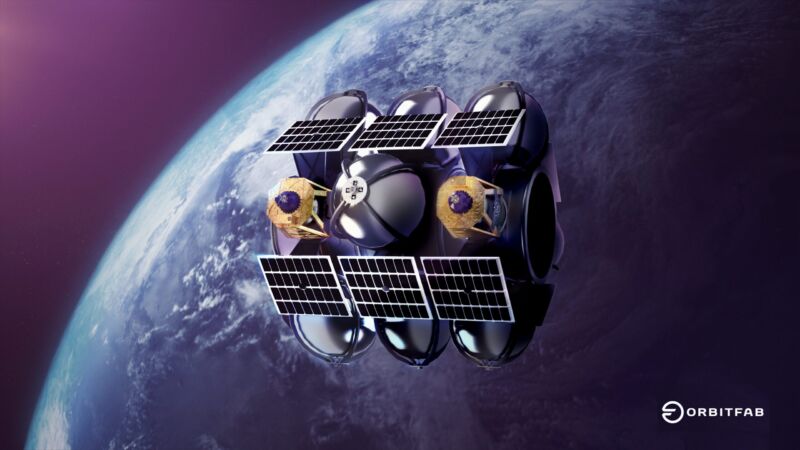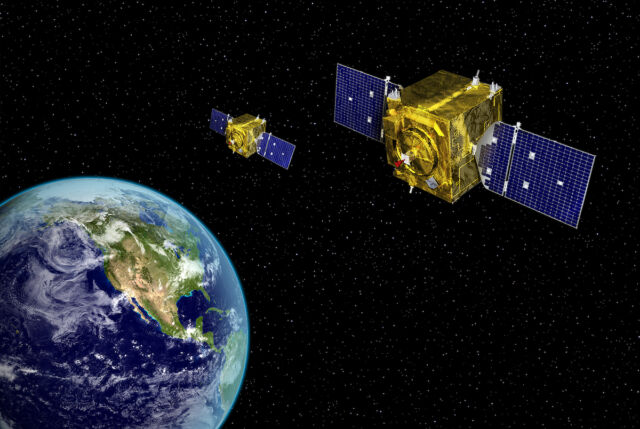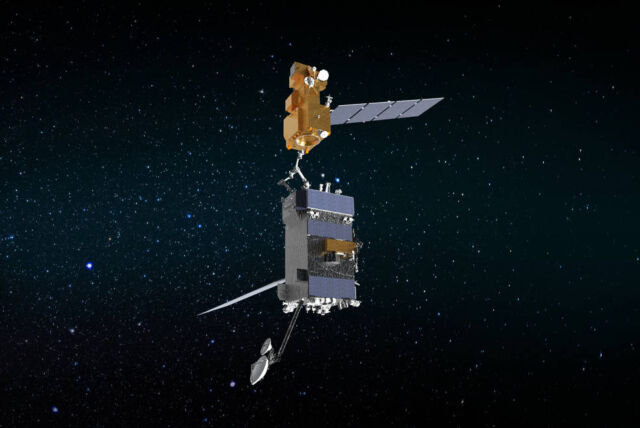
Imagine you purchased a vehicle that needed to last eight years on a single tank of gas. You would probably avoid sharp accelerations, keep a close eye on the fuel gauge, and wouldn’t leave the driveway unless it was a vitally important trip.
That was the analogy outlined Thursday by Lt. Gen. John Shaw, deputy commander of US Space Command, for how the Space Force operates its reconnaissance satellites.
“The way we've been doing space operations since the dawn of the Space Age—we’ve been doing it wrong,” Shaw said in an event hosted by the Mitchell Institute for Aerospace Studies.
The military’s fleet of communications, navigation, early warning, and surveillance satellites never stray far from their operational orbits. Each spacecraft has a finite amount of fuel for its thrusters to change altitude or inclination (the angle of its orbital flight path relative to the equator).
But it’s time for the military to transcend the orbital limits imposed by celestial mechanics on a satellite with a single tank of fuel, Shaw said.
"There's an emerging set of platforms that we think have to overcome this positional approach," he said. "And they need to probably spend most of their lifetime changing their energy state and maneuvering, as opposed to staying in orbit… We have satellites that have projected lifetimes measured in years and fixed fuel tanks, so we just can't do that. And that is constraining our ability to do a lot of things we want to do at US Space Command."
US Space Command’s area of responsibility extends from the top of the atmosphere to the Moon and beyond. The Space Force, established as a new military branch in 2019, is responsible for equipping Space Command and other regional commands around the world with weapons, sensors, and personnel to respond to hostile threats.
"I don't want Zeppelins anymore"
Shaw, as the second-ranking general at Space Command, said his team needs satellites that continuously maneuver in orbit.
He used the example of the US military’s neighborhood watch satellites roaming geosynchronous orbit more than 22,000 miles (nearly 36,000 kilometers) over the equator. In that orbit, a spacecraft’s velocity matches the rate of Earth’s rotation, making the geosynchronous belt a popular location for valuable communications, signals intelligence, and missile warning satellites.
The Space Force’s Geosynchronous Space Situational Awareness Program (GSSAP) satellites are designed to approach and inspect other objects in the geosynchronous belt, keeping tabs on Chinese and Russian spacecraft in similar orbits. The military has launched six GSSAP satellites to date.
"Their sole purpose is to move around the geosynchronous belt and to look at other platforms," Shaw said. "We'll look at our own platforms if something might be malfunctioning … And if there's something that's behaving suspiciously, we'll go look at that, too. It’s like the Coast Guard. We’re going to look at it and make sure we better understand what it is."

Shaw said the military is "constrained" with what it can do with the GSSAP satellites because ground controllers "have to think in terms of months and years" of fuel life with every decision on what and where to maneuver the spacecraft to approach another object in orbit. Each unit of fuel on a satellite translates to the spacecraft being able to change its velocity a certain amount—a measurement known as “delta-V” in the parlance of spaceflight.
"If we saw a satellite that was behaving suspiciously, but it was sufficiently far enough away from a GSSAP platform, it would take us a while to get there, given the limited fuel budget, and it may be determined that we just can't get there because it doesn't fit within the lifetime… This is basic astrodynamics with basic delta-V limitations."
"We can't have those constraints in the future," Shaw said.
Without the restriction of limited maneuverability, military satellites could respond "at will" to threats from an adversary. A satellite that can continually maneuver in orbit also makes for a less inviting target, Shaw said. "I think that has an inherent deterrent value—our ability to understand what's going on in the domain and respond."
One option to achieve that capability is in-orbit refueling.
"If I could refuel my GSSAP satellites once a month, we would be operating them completely differently than we do now," he said. "They'd be operating at maximum thrust levels."

But ground controllers have to account for fuel budgets and carefully plot out every maneuver. Low-impulse burns result in more gradual changes to a satellite's orbit, often eliminating any chance of catching an adversary by surprise.
"We’re kind of operating GSSAP today as if you did aerial reconnaissance with a Zeppelin," Shaw said. "I mean, we can do it. But you're not fooling anybody that you're coming. And you’re operating at the whims of the domain, and you’ve really got to figure out how am I going to do it? Do I just adjust my inclination a little bit? How do I do this? I’ve got to do it very carefully because I’ve got very little fuel. I don't want Zeppelins anymore."
While a GSSAP satellite—the Zeppelin airship in Shaw’s analogy—is purely a reconnaissance platform, the military might eventually want spacecraft with offensive and defensive capabilities, something akin to a fighter jet in the Air Force’s fleet.
"As we get more capabilities in the future that we see coming—F-15s in orbit—we can't fly an F-15 like we fly a Zeppelin," Shaw said. "That's not going to cut it."
Getting serious about in-orbit refueling
The Space Force is getting to work on projects to answer Space Command’s call. The military awarded a $44.5 million contract last year to Orion Space Solutions for the Tetra-5 experiment, a mission slated to launch in 2025 to demonstrate hydrazine refueling in geosynchronous orbit.
The Tetra-5 mission, developed in partnership with the Air Force Research Laboratory and the Defense Innovation Unit, will consist of three small satellites. The Tetra-5 spacecraft will link up in geosynchronous orbit with a fuel depot supplied by Orbit Fab and hosted on a satellite from Impulse Space. Orbit Fab, with early investment from industry giants Lockheed Martin and Northrop Grumman, is also providing the refueling port for the Tetra-5 demonstration. The refueling port is a device called the Rapidly Attachable Fuel Transfer Interface (RAFTI).
The Space Force is expediting its effort to field satellite servicing capabilities by focusing on technology that commercial companies already have in development, Maj. Gen. Stephen Purdy said in April. At the time, Purdy was in charge of the Space Force’s assured access to space division, but he now works at the Pentagon in the Space Force’s acquisition department.
Civilian satellites could also be attractive clients for satellite servicing companies.
"It is amazing how many companies are into on-orbit servicing and maneuvering; it’s actually hard to keep track," Purdy said. Dozens of companies participated in a satellite servicing industry day hosted by the Space Force last year.
Part of the military’s initial experiments in satellite servicing will involve testing standardized interfaces for refueling. One such interface is Orbit Fab’s RAFTI. Future satellites could be launched with built-in refueling plugs, but most military spacecraft in today’s fleet were not designed with servicing in mind.

Other companies working on satellite servicing or refueling include Maxar, which is the prime contractor on NASA’s OSAM-1 technology demonstration mission that will attempt to refuel an aging Landsat Earth observation satellite. OSAM-1, scheduled for launch in 2025, will attempt to prove that a servicing satellite can stick a refueling probe into the fuel tank of the Landsat 7 satellite "and not blow it up," Purdy said. "It’s actually fascinating, and I’m very very interested to see how that works."
SpaceLogistics, a subsidiary of Northrop Grumman, has docked two of its life extension vehicles to Intelsat satellites in geosynchronous orbit, providing maneuvering capability for spacecraft that are running low on fuel. The company next plans to launch a series of mission extension pods, or “jet packs,” to provide years of additional propulsion for customer satellites in orbit.
The Japanese company Astroscale is also developing experiments for in-orbit servicing, with eventual plans to apply the technology to removing space junk from orbit. A US company called Starfish Space launched its first satellite servicing tech demo experiment last month, but the mission ran into trouble soon after arriving in orbit.
Russia regularly refuels the International Space Station with Progress resupply freighters. And DARPA, the Pentagon’s research and development agency, tested satellite servicing and refueling tech on the Orbital Express mission in 2007, but there was no operational program ready to use it.
Maj. Gen. David Miller, the Space Force’s director of operations, has echoed Shaw’s comments on satellite refueling. He said the military’s satellite operators don’t want to get into a situation "where one maneuver alone takes us out of the fight or takes us off mission."
But satellite servicing may not be the only solution, particularly in an era where companies like SpaceX have developed mass-produced satellites for mega-constellations, such as the Starlink network.
Shaw said the Space Force could also look at launching cheaper satellites on a more regular cadence. "That's commoditization," he said. "I'll take a GSSAP (satellite) today, but I’ll need another one in two weeks because I’m going to fly the heck out of it. It’s going to empty that gas tank in a hurry."
Whatever the solution, Space Command wants it in place within five years for satellites with missions that require extensive maneuverability.
"For any platform that we think has to operate as a dynamic space operations platform, by 2028, we want to have a sustained maneuver capability," Shaw said.
reader comments
101